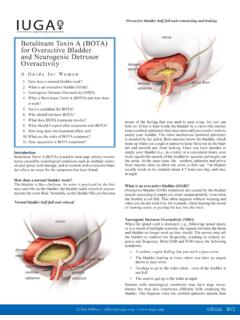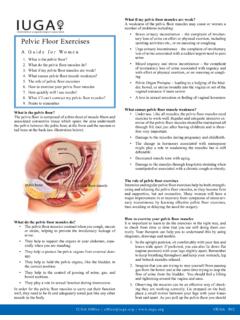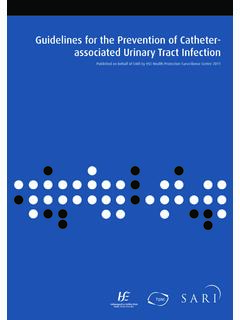Transcription of Urgency Overactive Bladder - Your Pelvic Floor
1 IUGA Office | | IUGA RV2 Overactive BladderA Guide for Women1. How does a normal Bladder work?2. What is Overactive Bladder (OAB)?3. What causes OAB?4. How is OAB assessed?5. What treatments are available?IntroductionOveractive Bladder is a very common problem that often causes distressing and inconvenient symptoms. It can cause you to rush to the toilet many times during the day and night, and can some-times also cause you to leak some urine before you reach the toilet. How does a normal Bladder work?The Bladder is similar to a balloon. Urine is produced in the kidneys and travels to the Bladder in tubes called ureters.
2 As the Bladder fills up, the walls stretch to accommodate the extra fluid. Urine is kept inside the Bladder by a valve-like mecha-nism (urethral sphincter) that stays shut until you feel the need to empty and have reached a toilet. The valve mechanism is as-sisted by the Pelvic Floor muscles below the Bladder , which tense up when you cough or sneeze and keep the urine in. As the blad-der fills up, you start to be aware of the feeling that you need to pass urine but are able to hold on. Once you have decided to empty your Bladder ( in a toilet, at a convenient time), your brain signals the muscle of the Bladder to squeeze and empty out the urine.
3 At the same time, the Bladder valve and Pelvic Floor muscles relax to allow the urine to flow out. The Bladder usually needs to be emptied about 4-7 times per day, and once at is Overactive Bladder (OAB)?OAB is the name given to the following collection of Bladder symptoms: Urgency a sudden and intense need to pass urine that cannot be put off. This can happen even when your blad-der is not full. Sometimes you may not make it to the toi-let in time and may leak. This is called urge incontinence Frequency going to the toilet many times during the day (usually more than 7).
4 Nocturia waking up more than once at night to go to the affects women (and men) of all ages and is not simply a result of getting urinary TractkidneysuretersbladderurethraNormal Bladder , half full and relaxedOveractive Bladder , half full but contracting, causing urinary leakagebladderuterusrectumureterpelvic floorvaginaurineurethraWhat causes OAB?OAB symptoms are caused by the Bladder muscle squeezing to empty out urine inappropriately. This often happens without warning, and when you do not want it doctor or nurse will test your urine to rule out an infection, which is a common cause of OAB symptoms.
5 You may have oth-er tests to look for Bladder stones and growths as well. OAB can also be caused by conditions affecting the nervous system. If you have had a previous operation for stress incontinence, you may also be more likely to have OAB. The amount and type of liq-uids that you drink may also contribute to your symptoms. For example, caffeinated drinks are thought to significantly worsen OAB Office | | IUGA RV2 For many women, however, the exact cause of their OAB is nev-er found. Despite this, there are many treatments which can help you to manage your is OAB assessed?
6 When you see your doctor, he/she will ask you questions about your Bladder , fluid intake and general health. You will then be examined to rule out any gynecological problems that may be contributing to your problem. You may be asked to fill in a blad-der diary, which involves recording what and how much you drink and the volume of urine that you pass each time you go to the bathroom. This provides useful information on how much you are drinking and how much your Bladder is able to hold. Ask your doctor about a Bladder diary of the tests that you may have are: Urinalysis testing a sample of your urine to find out if there is an infection or any blood in the urine.
7 Residual urine using an ultrasound machine (or some-times inserting a small catheter) to check whether you are emptying your Bladder properly. Urodynamics this test is able to examine the activity of the Bladder muscle as it is filled with fluid. Urodynamics can tell your doctor whether your Bladder muscle squeez-es inappropriately as the Bladder is filled (this is known as detrusor overactivity ), as well as whether the blad-der valve is leaky ( stress incontinence ) and whether the Bladder empties treatments are available?There are many different treatments available for OAB.
8 There are also changes that you can make to your lifestyle which can significantly improve your containing caffeine, for example, coffee, tea, and cola, can significantly worsen OAB symptoms. It may be very help-ful to reduce the number of these types of drinks to see if this helps. Fizzy drinks, fruit juices, and alcohol can also cause OAB symptoms. Try keeping a Bladder diary to see if you can find out which drinks make your symptoms worse. You could try switching to water, herbal teas, and decaffeinated drinks. Although it is tempting, try not to cut down the amount you are drinking; aim to drink about to 2 liters per day (about half a gallon).
9 Bladder Training. You may be in the habit of going to the toilet very often so that you are not left in a situation where you need to urinate and are not near a toilet. This can make OAB even worse, as your Bladder becomes conditioned to hold less and less urine. Bladder training aims to help you hold more urine in your Bladder by going to the toilet less often. It involves gradu-ally increasing the time between visits to the toilet and trying to hold on for a little longer if you experience the urge to empty your Bladder . Your doctor or physical therapist can give you more information regarding this treatment.
10 This is covered in more detail in the leaflet entitled Bladder There are a variety of different medications that can help with an Overactive Bladder . Although these may be prescribed by your doctor, it is still important to control what you are drinking and to try to train your Bladder . The medica-tions are designed to enable you to hold on for longer, reduce how often you need to go to the toilet (both during the day and The information contained in this brochure is intended to be used for educational purposes only. It is not intended to be used for the diagnosis or treatment of any specific medical condition, which should only be done by a qualified physician or other health care ) and to reduce leaking.






